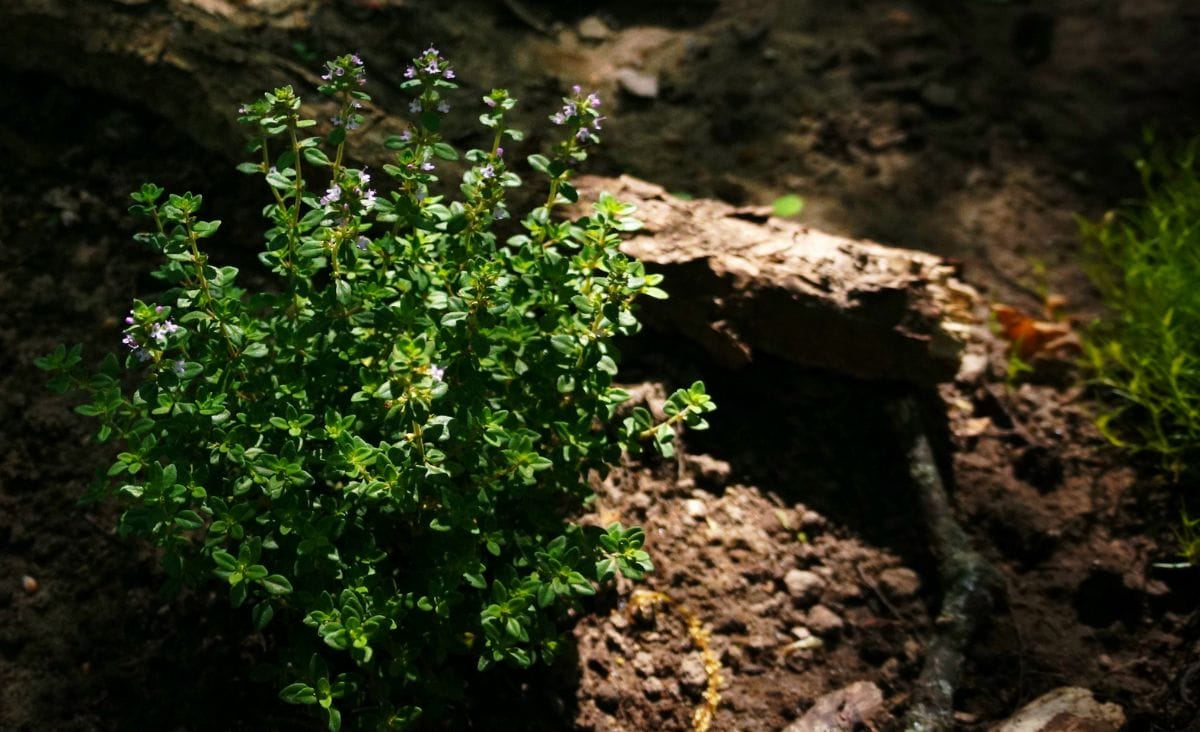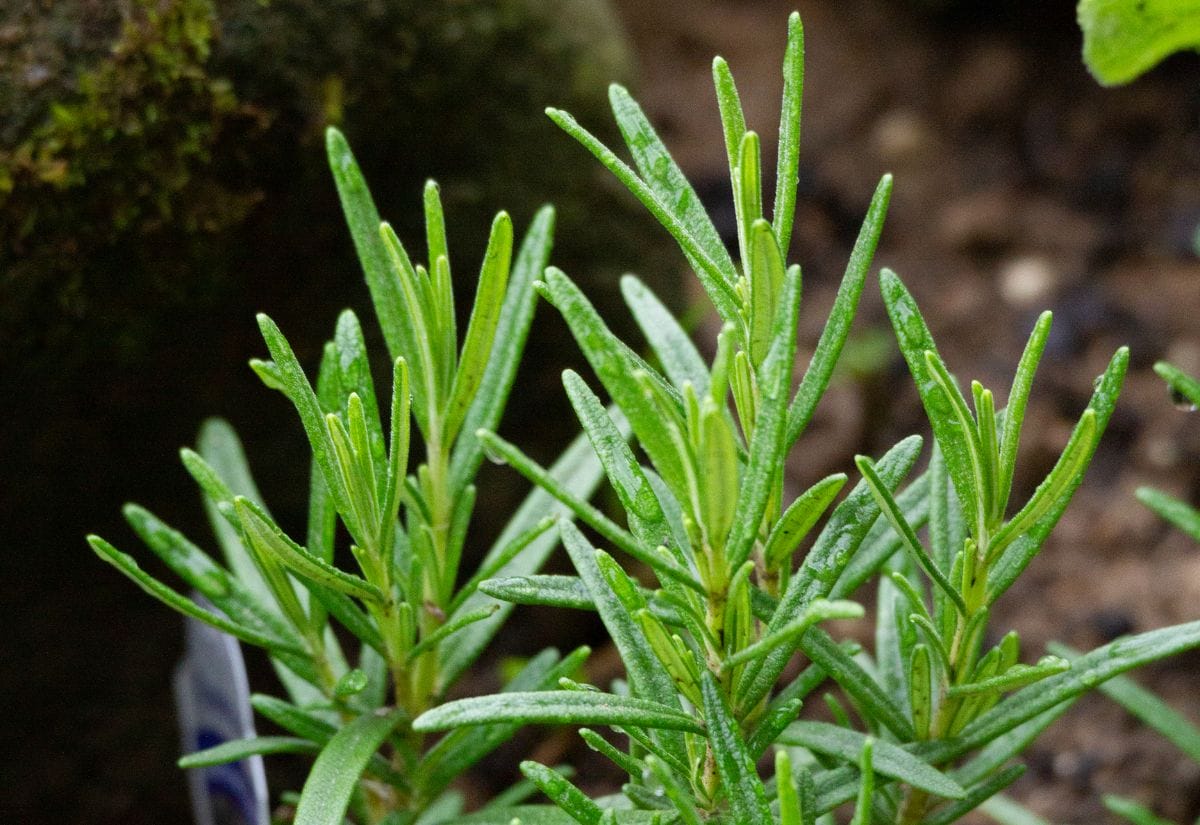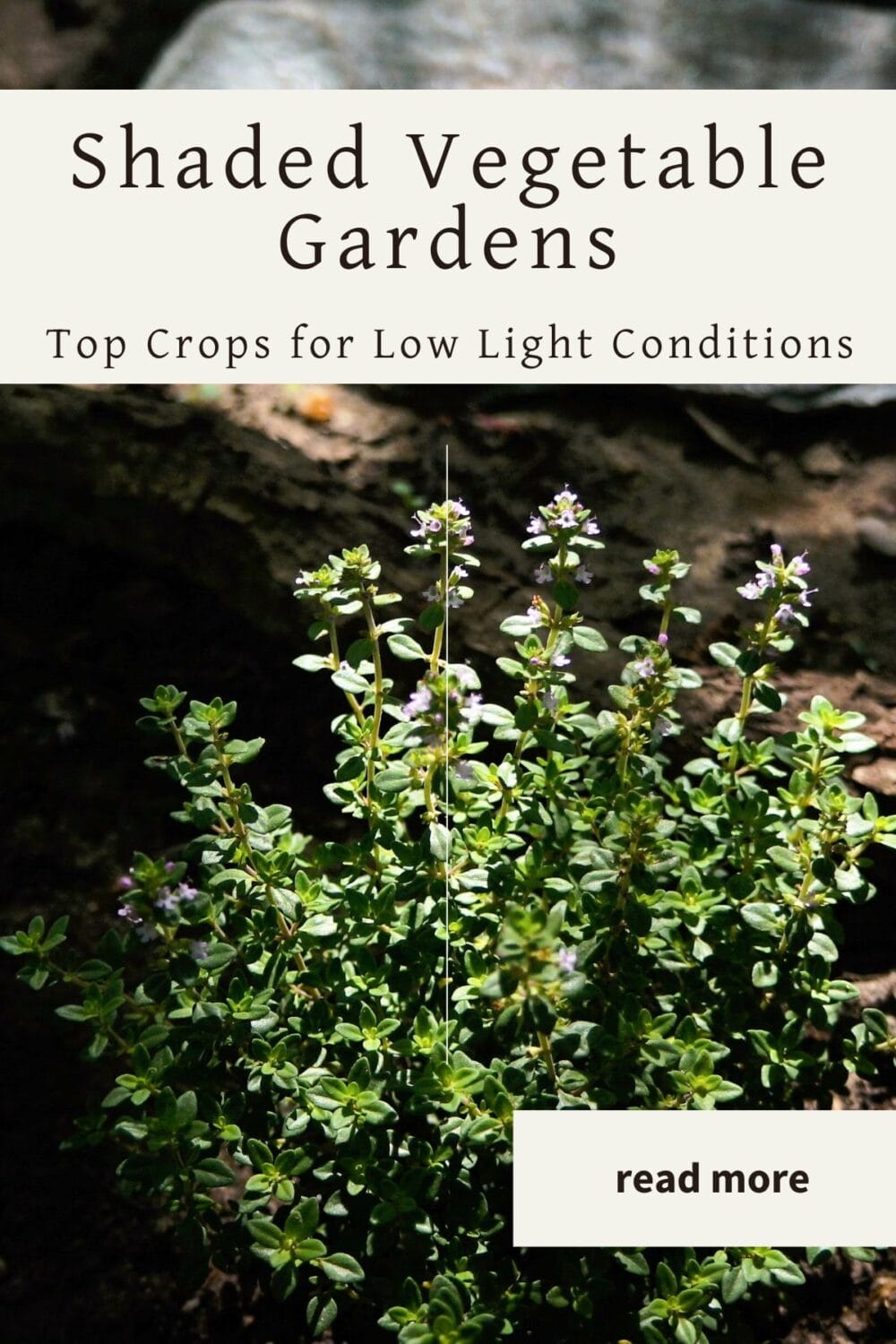Shaded Vegetable Gardens: Top Crops for Low Light Conditions
How to grow the best shade-tolerant vegetables and herbs. Perfect for homesteaders looking to grow food in every corner of their space.

I personally think that spring planning is the only way to survive the winter months. I sketch and make lists, research, and sketch some more. I even go as far as making outlines that point to companion plantings. You don’t have to go that far, but I actually enjoy it.
It can be hard to garden in shady spots because you do not know what will grow and you have to deal with a lot of restrictions. But if you know what plants to choose and how to plant them, even the darkest parts of your garden can become green and productive.
This post goes into detail about how to garden in different levels of shade, from light to deep, and lists the herbs and vegetables that do best in each.
I will show you how to make the most of your shaded garden space so you get a harvest that defies the darkness, even if your trees let in a little light or a north-facing wall casts a constant shadow.
How Shaded is Shaded?
Knowledge of the various levels of shade is important for gardening because it affects what you can plant and how well it will grow. Shade in the garden is not a one-size-fits-all condition; it varies in intensity and can significantly impact plant health, flowering, and yield.
Light shade is used to describe places that get filtered or dappled sunlight all day. This can also mean places that get direct sunlight for three to six hours a day, preferably in the early morning or late afternoon when it is cooler. Lightly shaded gardens are good for plants that like to be protected from the hot midday sun, like many types of greens and some herbs.
Places that get dappled shade for most of the day and only two to four hours of direct sunlight are considered to have partial shade. This is a great spot for plants that need some sunlight but need to be protected from the hot afternoon sun. Partially shaded areas are good for growing leafy vegetables like spinach and lettuce, which like it cooler.
As the name suggests, full shade areas never get direct sunlight. Either they do not get any sunlight at all, or they only get indirect sunlight. This is the hardest situation for vegetable gardening because it limits the types of plants that can be grown successfully. A few leafy greens may do well in full shade. Several herbs, such as mint and parsley, can handle full shade, but their flavors may be weaker than what you’re accustomed to.
Deep shade means there is almost no light coming in. It can be found under a thick canopy of evergreen trees or on the north side of buildings, where sunlight does not get through. With so little light, it is the hardest kind of shade for gardening. Not many plants can do well in deep shade, and the ones that can are usually foliage plants that are grown for their leaves rather than their flowers or fruits.
Deciding if a Plant is Shade Tolerant
When deciding which crops to grow in partial shade areas, think of which part of the plant we consume. Crops where we eat the leaves or roots tend to do fairly well in partial shade conditions. This makes sense from a botanical perspective: these plants naturally prioritize root and leaf development over fruit production, requiring less direct sunlight to photosynthesize effectively. Crops where we eat the fruits really do need at least six hours of full sun per day.

Shade-Tolerant Vegetables
There are a surprising number of vegetables and edibles that will grow in shade. This isn’t an all-inclusive list, but it provides some options to get you started.
Full-Shade Tolerant
While no vegetable can grow in complete darkness, these can survive in areas with very limited direct sunlight (less than 3 hours), relying mostly on indirect or filtered light:
Herbs
- Mint
- Parsley, weaker flavor
- Chives, most likely, will not flower
Partial Shade Tolerant
These vegetables can thrive with 3 to 6 hours of direct sunlight per day or in areas with dappled sunlight throughout the day:
Leafy Greens
- Spinach
- Swiss chard
- Kale
- Mustard greens
- Arugula
Root Vegetables
- Radishes
- Beets
- Carrots, may produce smaller roots
Herbs
- Parsley
- Cilantro
- Mint
- Chives
Light Shade Tolerant
Vegetables in this category can grow in areas that receive 4 to 6 hours of direct sunlight or consistent, filtered light throughout the day:
Leafy Greens
- Lettuce
- Endive
- Collards
Root Vegetables
- Turnips, for greens
- Potatoes, might produce fewer tubers
Brassicas
- Broccoli
- Cauliflower
Legumes
- Peas
- Green Beans, may yield less than in full sun
Tips for Shady Vegetable Gardening
I have discovered that shady vegetable gardens require a bit more care than your traditional garden beds. Here are some tips to make the most of your garden space.
Soil Quality is Key
Shade-grown vegetables need rich, well-draining soil to compensate for the lower light levels. Enhance your soil with compost and organic matter to provide the nutrients your plants will need to thrive.
Water Wisely
Shaded areas can retain moisture longer, reducing the need for frequent watering. However, it’s crucial to monitor the soil moisture closely, as overwatering can lead to root rot and other diseases.
Maximize Light
Trim or thin overhead branches if possible to increase light penetration. Reflective mulch or surfaces near your garden can also help to brighten the area around your shade-tolerant plants. I’ve even used mirrors I purchased at the local thrift store to lean against our fence and bounce light.
Spacing Matters
Avoid overcrowding your plants. Proper spacing ensures that each plant receives its fair share of sunlight, air circulation, and nutrients. I find that if I plant my plants as close as I would in our sunny gardens, the plants fail to thrive.
Patience Pays Off
Vegetables grown in the shade might take a bit longer to mature than those grown in full sun. This isn’t always a bad thing! Vegetables that are prone to bolting in the summer do much better in the shade. Adjust your expectations and enjoy the slower pace of your shade garden’s growth.
Frequently Asked Questions
For people who want to learn more about gardening, I have a lot of information that can help you with different parts of growing your own food. If you’re someone who prefers a more laid-back approach to gardening, my post on The 15 Easiest Vegetables for Lazy Gardeners to Grow will be right up your alley, offering a list of low-maintenance crops that promise a bountiful harvest with minimal effort.
Growing a garden can be hard if you do not have enough space or if the soil is not exactly perfect. How to Start a Garden in Your Yard, No Matter the Space or Soil gives you tips and ideas on how to get around these problems and grow a successful garden. If you want to grow your own food, you do not need a huge backyard. My post on small space vegetable gardening is full of creative ways to garden in small areas.
These posts offer a comprehensive toolkit for making the most of your gardening journey, regardless of your space, experience level, or preferred gardening style.
If you’ve found value in this blog post and enjoyed reading it, why not share it with your Pinterest community? Pin the image below and spread the love!

Knowing that you don’t need full-sun for all your crops opens up a lot of doors when it comes to planning for your garden. Maybe, like me, you will realize that you can sacrifice a bit of lawn, and instead of spending your time mowing, you can be spending your time collecting food for your table.
What are your own experiences with gardening in shaded areas? Have you discovered any tips or tricks that helped your shade-tolerant plants thrive, or do you have a favorite shade-loving vegetable or herb that wasn’t mentioned here?

We have had great success with carrots, beets, lettuce broccoli, cauliflower, Brussels sprouts, cabbage, scallions, spinach, but potatoes we felt needed sun for the foliage to do well until the harvest. We live in CA on 2/3 of an acre and have raised beds filled with a mixture of 50/50 mushroom soil and potting/compost soil. There is a mushroom farm close to us that gives its soil away for free unless you need more than you can haul yourself. They sterile the soil before planting so there are no weeds or pests in it. It’s high in nitrogen so needs to be diluted with the other soils or it will burn seedlings. It amazing stuff and our plants grow to enormous sizes and health. It’s 99% organic. Ck it out if you have a mushroom farm near you.
Sadly I have a yard that is shaded by maples front and back. By June with the leaves and the sun’s arc, no area gets more than 1 hour of light a day. But we had moved here to grow things! LOL
So I was so enthused when I found a list of ‘shade-growing veggies’ (similar to yours), and planted 10′ rows (or more of some)… It was a lot of hoe and rake work, but this soil is nutrient rich and full of eathworms!
I planted: broccoli, snap peas, parsley, radish, carrots (the tiny French kind), 4 kinds of lettuce (including Tom Thumb), beets, turnip, cilantro, and about 6 other things I can’t right now recall, as well as garlic…
NONE of them got over 6″ high the entire summer. They just ‘stayed alive’.
The radishes didn’t come up at all. The peas looked good but scraggly -maybe like normal at that stage, but they were eaten at 6″ anyway (wildlife abounds). The lettuces got 4 leaves about 4″ – all of them, and then quit. The garlic was dug up this spring and planted with what I’d saved over winter in the fridge- we paid for 2 plots in the sunny community garden.
I’m sure there are some shade-loving plants out there, that do well – (my wild orange daylily is doing great!) but as for gardening for food- well, I guess I just set myself up for disappointment – partial shade is not the same as shaded, and 1 hr of sunlight equaled 0 shade in this equation.
Better luck to you all!
I’m sorry you didn’t have luck. Yeah, edibles are tough with just an hour of sun.
Great list. My favorite being (well, besides all of them) the kale. So easy to grow with little sun and it is a super food.
Kale is super versatile too. I hide it in all sorts of my kids’ meals.
Oh it should also be mentioned that we planted the seeds outdoor directly in the bed.
Hi there, I hope you still read this post’s comments! We just planted our first garden in a raised bed. We planted veggies for their leaves and / or roots only. The bed gets a good 4 hours direct sunlight a day and the rest is still bright but filtered light, never really in true shade. I’ve always read these plants can do well in the shade, yet my seedlings are so leggy. Do you know why this would be if they are truly a shade tolerant plant? (i.e. leggy lettuce, kale, radish (only a few of the bed), spinach, and cilantro). Would love your advice on anything I could do to help them make it!
You might have better success transplanting versus direct sowing. In the early stages, those plants are going to reach for the light, resulting in leggy plants.
Blackberries and sweet potatoes need full sun. They can take afternoon shade. In fact sweet potatoes need heat. Herbs may not be as full in partial sun.
Beans actually can grow in some shade too.
good post however the sweet potato part , i read that it likes full sun. i have sweet potato and it loves the sun at least 6 hours.. thanks for the info
The harvest may not be as good, but they will grow in less. Of course, the more sun you can offer, the better, but even those who don’t have full sun, you can still have sweet potatoes.
I’m thankful for the shade vegetables list you created. One thing about shade that you don’t mention in your article: It generally, at least in my yard, comes from trees and those trees’ root systems can be a barrier for most plants. Some, like maples and nut trees, exude poison from the roots and from the dead leaves that can kill many plants, even shade plants like Hostas. Then, too, trees are great suckers of moisture, so any shade garden will need double or triple the water than other gardens simply because tree roots will suck up most rain and hose water and then those roots will grow even larger and more thirsty as they elongate their reach. The only way I have found to raise plants in tree-shaded areas is to plant in raised beds that have floors to keep tree roots at bay. If folks have shade from innocuous things like buildings, then they shouldn’t be concerned with my complaint, but if their shade comes from trees, better consider the type and size of the trees before going through the work of establishing a garden under the trees’ canopy.
That is very true Delores and thank you for mentioning it. I haven’t had much trouble with maples, but I know walnut and pine trees can cause headaches. If you are planting under troublesome trees, it’s best to use containers.
What a great post on shade gardening.I have a real nice area on the side of our house I’ve been considering doing.Kale, herbs, turnips, leeks. ….I’m so excited to get started!!!
Keep up the GREAT WORK !
Glad to help 🙂
Keep in mind the difference of the angle of the sun during the winter versus the angle of the sun during the summer. I was planning on planting grapes along a fence line, but was discouraged when I saw it was in shade consistently during the winter. During the summer growing season, the grape garden is in full sun. Makes a difference in choose those garden plants!
Great point Lorrie. The best time to do sun maps are at the beginning, middle and end of the growing season.
Great post!! We are going to have to learn how to grow more in the shade. Our back yard neighbors just put up a new fence that will shade the first two beds of our garden for most of the year so this is a gardening skill I’m going to have to acquire fast!!
Thank you so much for posting this, I would love for you to share this on Real Food Fridays.
http://yourlife7.blogspot.com/2014/04/real-food-fridays-35-link-up.html
Very timely! I just walked in all dirty from planting spicebush amongst the PawPaw patch I put in yesterday. Also a couple more gooseberries sprinkled about. We have quite a bit of space just north of our woods and to the east of the house that is pretty shady. Thanks for the list. A few in there I didn’t realize do well.
Great post! We just did a shade survey to find out how much of it we have in our garden. Now I am looking for what to plant in those shady spots. This will be helpful. However, since our weather is more on the cool side, we need to be careful. have you had good experiences with growing potatoes in the shade? How much shade?
I can’t be sure of the exact amount of sunlight in the area I planted, but it was fairly shaded by a tall fence and a shed. I got lots of potatoes, but they were smaller than I usually get. Perfect for stews, but not great for baking.
I’m in Maine, so I feel for you with the cold climate. I’m using cold frames and mini greenhouses to add to my short growing season.
Thank you! It sounds like it is worth to try. Yes the short growing season is a bit of a pain. But we are thankful for what we get.